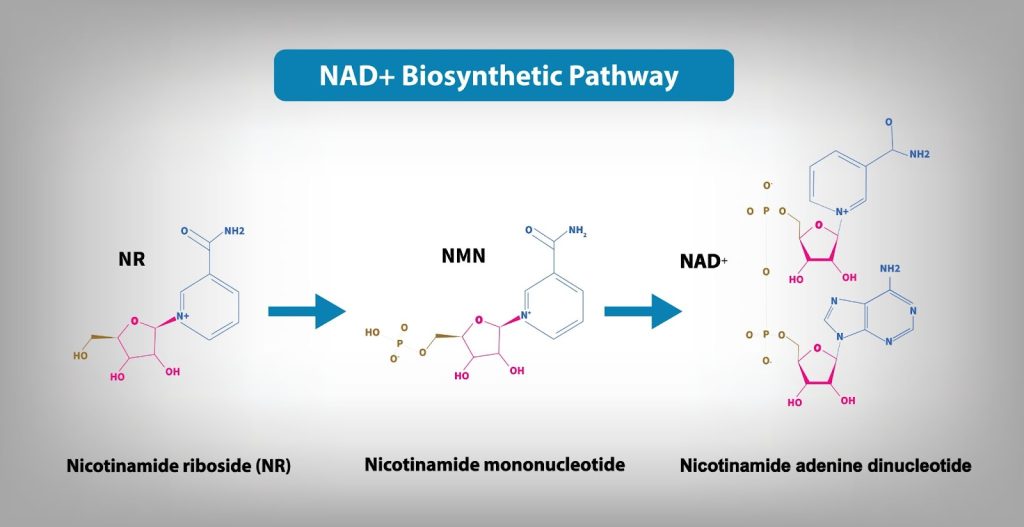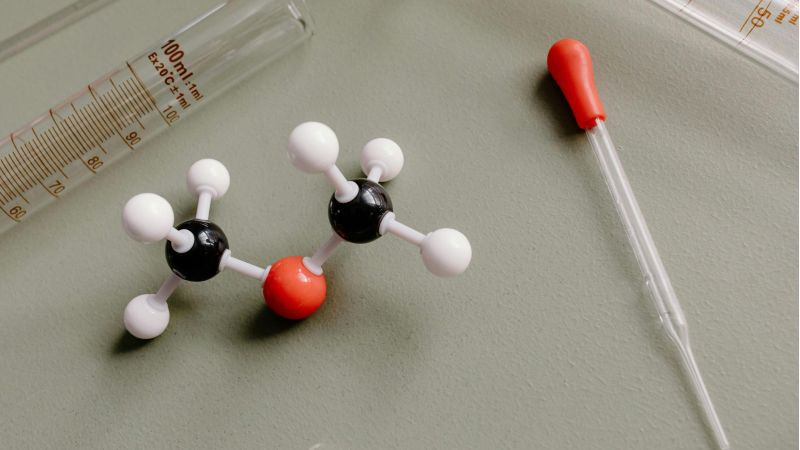
Unraveling the Mystery: Understanding What NAD Is and Its Importance
Nicotinamide adenine dinucleotide, commonly known as NAD, is a coenzyme found in all living cells. Its importance lies in its role as a critical component in several essential biological processes. By unraveling the mystery surrounding NAD, you can gain valuable insights into its functions and understand its significance for overall health and well-being.
Decoding the Acronym: What is NAD?
At its most basic definition, NAD is a molecule that participates in numerous enzymatic reactions within cells. It acts as a coenzyme, meaning it assists enzymes in facilitating chemical reactions. In simple terms, NAD is involved in cellular metabolism, playing a crucial role in energy production and DNA repair.
The Basic Definition of NAD
NAD is a dinucleotide, meaning it consists of two nucleotides joined by a phosphate group. The nucleotides in NAD can be either adenine and ribose (forming NAD+) or nicotinamide and ribose (forming NADH). The “+” or “H” symbolizes the oxidized or reduced state of NAD, respectively.
The Scientific Explanation of NAD
From a scientific perspective, NAD’s significance lies in its ability to act as an electron carrier during redox reactions. In these reactions, NAD accepts and donates electrons, which are crucial for energy transfer within cells.
Moreover, NAD’s involvement in the redox reactions is essential for the conversion of food into energy. It helps break down carbohydrates, fats, and proteins, enabling cells to produce ATP (adenosine triphosphate), the energy currency of the body.
It is important to understand the role of NAD in cellular metabolism. One of the critical functions of NAD is its involvement in glycolysis, the initial step in the breakdown of glucose. During glycolysis, glucose is converted into pyruvate, generating a small amount of ATP and reducing NAD+ to NADH.
But NAD’s role doesn’t stop there. NADH, the reduced form of NAD, carries the high-energy electrons extracted from glucose to the electron transport chain (ETC) in the mitochondria. The ETC is a protein complex series that transfers electrons and generates a proton gradient across the inner mitochondrial membrane.
As the electrons move through the ETC, energy is released and used to pump protons across the membrane. This creates a proton gradient, which drives the synthesis of ATP through a process called oxidative phosphorylation. NADH plays a crucial role in this process by donating its electrons to the ETC, ultimately leading to the production of ATP.
In addition to its role in energy production, NAD is also involved in DNA repair1. When DNA is damaged, enzymes called poly(ADP-ribose) polymerases (PARPs) utilize NAD+ to add ADP-ribose units to proteins, including histones and DNA repair enzymes. This process, known as ADP-ribosylation, helps recruit and activate DNA repair machinery, ensuring the integrity of the genome.
Furthermore, NAD is important for cellular metabolism and DNA repair and plays a role in regulating various cellular processes. It acts as a signaling molecule, influencing gene expression, cell survival, and aging. NAD-dependent enzymes, such as sirtuins, are involved in regulating cellular processes like DNA repair, metabolism, and stress response.
In conclusion, NAD is a versatile molecule that plays a critical role in cellular metabolism, energy production, DNA repair, and cellular signaling. Its involvement in redox reactions, glycolysis, electron transport chain, and ADP-ribosylation highlights its significance in maintaining cellular homeostasis and overall organismal health.
The Role of NAD in the Human Body
NAD (Nicotinamide Adenine Dinucleotide) is a crucial molecule involved in various cellular functions that are vital for the proper functioning of the human body. It plays a fundamental role in maintaining cellular health, regulating metabolism, and supporting overall well-being.
NAD and Cellular Function
Within cells, NAD plays a critical role in regulating cellular processes, such as DNA repair, cell signaling, and gene expression. It acts as a coenzyme for enzymes involved in these processes, ensuring their proper functioning.
One of the key functions of NAD is its involvement in DNA repair mechanisms. DNA damage can occur due to various factors such as exposure to radiation, environmental toxins, or normal cellular processes. NAD helps activate enzymes called PARPs (Poly ADP-ribose polymerases), which are crucial in repairing damaged DNA strands. This repair process is essential for maintaining genomic stability and preventing the accumulation of mutations that could lead to diseases like cancer.
Besides DNA repair, NAD is also involved in maintaining the health and stability of the mitochondria, the powerhouses of the cell. It assists in the production of ATP (Adenosine Triphosphate), the main energy currency of the cell, through a process called oxidative phosphorylation. NAD is a key player in the electron transport chain, which generates ATP by transferring electrons from NADH to oxygen. This process ensures a steady supply of energy for cellular activities and helps prevent oxidative damage, thus promoting overall cellular health.
NAD’s Impact on Metabolism
NAD’s importance in metabolism cannot be overstated. It acts as a key regulator of metabolic pathways, influencing processes such as glycolysis, the Krebs cycle, and fatty acid oxidation. By facilitating these processes, NAD helps extract energy from nutrients and ensures a smooth metabolic flow within cells.
One of the critical roles of NAD in metabolism is its involvement in glycolysis, the initial step of glucose metabolism. NAD serves as a coenzyme for enzymes involved in glycolysis, allowing the breakdown of glucose into pyruvate and generating ATP. This process is essential for providing energy to cells, especially when oxygen availability is limited, such as during intense exercise or in certain disease conditions.
In addition to its role in glycolysis,2 NAD is also involved in the Krebs cycle, known as the citric acid or tricarboxylic acid cycle. This cycle is a central hub for the oxidation of various fuel molecules, including glucose, fatty acids, and amino acids. NAD acts as a coenzyme for several enzymes in the Krebs cycle, facilitating the transfer of electrons and the production of high-energy molecules like NADH and FADH2. These molecules are then used in the electron transport chain to generate ATP, providing the energy needed for cellular processes.
Furthermore, NAD regulates the balance between anabolic and catabolic processes. Anabolic processes involve synthesizing complex molecules from simpler ones, while catabolic processes involve breaking complex molecules into simpler ones. NAD participates in both types of processes, ensuring efficient utilization of nutrients and preventing metabolic imbalances. It helps regulate the activity of enzymes involved in anabolic and catabolic pathways, maintaining metabolic homeostasis and supporting overall health.
In conclusion, NAD is a multifaceted molecule that is crucial in various cellular functions and metabolic processes. Its involvement in DNA repair, cellular signaling, energy production, and metabolic regulation highlights its significance in maintaining cellular health and overall well-being. Understanding the role of NAD in the human body provides valuable insights into the intricate mechanisms that govern our biological systems.
The Importance of NAD for Health
Maintaining optimal NAD levels is crucial for overall health and well-being. NAD, short for Nicotinamide Adenine Dinucleotide, is a coenzyme found in all living cells. It is vital in various biological processes, including energy production, DNA repair, and cellular signaling.
As we age, our NAD levels tend to decline. This decline is associated with various age-related conditions, including reduced energy production, impaired cellular function, and increased disease susceptibility. The decline in NAD levels is thought to contribute to the aging process itself.
However, by maintaining adequate NAD levels, it is possible to support healthy aging and promote longevity. NAD supplementation and lifestyle interventions can potentially help counteract age-related NAD depletion.
NAD and Aging
“The loss of NAD as we age, and the resulting decline in sirtuin activity, is thought to be a primary reason our bodies develop diseases when we are old, but not when we are young.” – Dr. David Sinclair, Harvard Medical School, Lifespan
Research has shown that NAD levels tend to decline with age. This decline is associated with various age-related conditions, including reduced energy production, impaired cellular function, and increased disease susceptibility.
One of the key factors contributing to the decline in NAD levels is the activity of an enzyme called CD38. CD38 breaks down NAD into its constituent parts, leading to a decrease in NAD availability. Other factors, such as oxidative stress, inflammation, and mitochondrial dysfunction, can also contribute to NAD depletion.
By maintaining optimal NAD levels, it is possible to support healthy aging. NAD is involved in several critical processes that decline with age, including DNA repair, cellular metabolism, and mitochondrial function. Replenishing NAD levels may slow aging and reduce the risk of age-related diseases.
Furthermore, NAD is involved in the regulation of sirtuins, a family of proteins that play a crucial role in cellular health and longevity. Sirtuins are involved in various processes, including DNA repair, gene expression, and stress response. By maintaining adequate NAD levels, it is possible to support the activity of sirtuins and promote healthy aging.
NAD and Disease Prevention
Emerging studies suggest that NAD plays a role in disease prevention by regulating various cellular processes. Increasing NAD levels may help protect against neurodegenerative diseases, cardiovascular conditions, and metabolic disorders.
In neurodegenerative diseases such as Alzheimer’s and Parkinson’s, NAD has been found to play a crucial role in maintaining neuronal health. NAD supports mitochondrial function, reduces oxidative stress, and promotes the clearance of toxic proteins associated with these diseases.
In cardiovascular conditions, NAD has been shown to regulate blood vessel function and reduce inflammation. By maintaining optimal NAD levels, it may be possible to support cardiovascular health and reduce the risk of conditions such as atherosclerosis and heart disease.
In metabolic disorders such as obesity and type 2 diabetes, NAD is involved in regulating energy metabolism and insulin sensitivity. By increasing NAD levels, it may be possible to improve metabolic health and reduce the risk of these conditions.
However, further research is needed to fully understand the extent of NAD’s protective effects and its potential in therapeutic interventions. Scientists are actively studying the role of NAD in various diseases and exploring strategies to modulate NAD levels for therapeutic purposes.
In conclusion, maintaining optimal NAD levels is crucial for overall health and well-being. NAD depletion is associated with various age-related conditions and diseases. By understanding the importance of NAD and implementing strategies to support its levels, it may be possible to promote healthy aging and reduce the risk of age-related diseases.

How to Maintain Optimal NAD Levels
Several factors influence NAD levels, and taking proactive steps can help preserve and enhance NAD levels.
Diet and NAD Levels
Consuming a healthy and balanced diet is essential for maintaining optimal NAD levels. Foods rich in niacin, an essential vitamin and precursor for NAD synthesis, can support NAD production. These include lean meats, fish, legumes, and whole grains.
Supplements for Boosting NAD
Moreover, certain dietary supplements, such as nicotinamide riboside and NAD+ precursor, have shown potential in increasing NAD levels. However, consulting a healthcare professional before starting any supplements is recommended.
The Future of NAD Research
The growing interest in NAD research has paved the way for potential therapeutic uses and the exploration of unanswered questions.
Potential Therapeutic Uses of NAD
Researchers are exploring the therapeutic potential of NAD in various areas, including neurodegenerative diseases, metabolic disorders, and age-related conditions. NAD-boosting interventions, such as supplementation and lifestyle modifications, may offer promising avenues for future treatments.
Unanswered Questions in NAD Research
While NAD’s importance is becoming increasingly recognized, many unanswered questions remain. Scientists are working to understand the precise mechanisms through which NAD influences cellular processes and diseases. Additionally, ongoing research aims to optimize NAD-boosting interventions and determine their long-term effects.
Conclusion
In conclusion, NAD is a vital coenzyme involved in multiple cellular processes. Its functions extend beyond energy production, playing a crucial role in cellular health, metabolism, and disease prevention. By understanding NAD and its importance, you can explore strategies to maintain optimal NAD levels and potentially unlock its therapeutic potential. Future research holds great promise in uncovering new insights into NAD’s role in human health and further enhancing our understanding of this fascinating molecule. Are you deficient in NAD? Measure your NAD level with this affordable NAD test from Jinfiniti.
Lastly, if you’re interested in going deeper on health-related content, here are a few of our recent posts that you may want to read:
- What Does Peak Performance Look Like?
- Why Optimized, Precision Medicine is the Future
- 9 Powerful Benefits of Optimizing Your NAD
- Andrew Huberman is Wrong About NAD, NAD+ precursor & Longevity
Referenced Sources:
Read More














